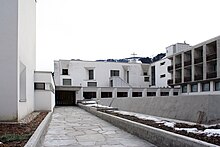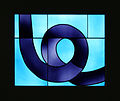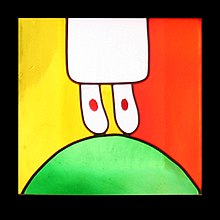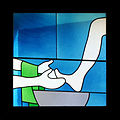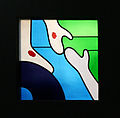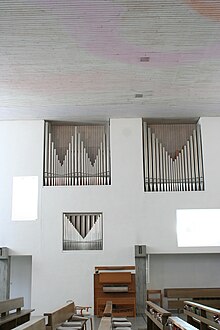Ilanz Monastery
The monastery Ilanz is a Dominican convent in the town of Ilanz / Glion in Switzerland's canton of Grisons . It is the motherhouse of the Congregation of the Ilanz Dominican Sisters .
history
The founders of the Ilanzer sister community
The founder of the Ilanz Monastery was Johann Fidel Depuoz (* 1817 in Siat ; † 1875 in Ilanz) from Graubünden . He entered the Jesuit order in 1840 , was trained as a theologian and ordained a priest in the order. For 20 years Depuoz worked abroad, including a. in Savoy , Maryland USA, Tronchiennes, Liège , Leuven , Munster , southern Germany , Solferino , Padua and Dubrovnik (then Ragusa). Because the Jesuit order was banned in Switzerland in the meantime, Depuoz left this order in 1860. He wanted to promote education and alleviate social hardship in his homeland, Surselva in Graubünden. First he did his doctorate in theology in Rome . In the following years he worked in Chur , Schleuis-Löwenberg and finally in Ilanz as a pastor, teacher, educator and director of its establishment.
Babette Gasteyer (* 1835 in Nastätten in Hesse-Nassau , † 1892 in Ilanz) in Wiesbaden trained and worked as teacher at aristocratic courts in Germany, Austria and Moravia operates such. T. also as a nurse. In 1866 she was hired by Johann Fidel Depuoz as a teacher. As a nun she gave herself the name Sr. Maria Theresia.
In the years 1865–1868 Depuoz founded - from 1867 together with Sr. Maria Theresia Gasteyer - the Ilanzer Sisters' Community, the Society of Divine Love on the basis of private law. The community opened the institute school in Ilanz in 1865 and the Ilanz Hospital in 1868 . The aim of the school and the hospital was to promote the education of girls and adults as well as the professional treatment of the sick in the Surselva. After the death of Johann Fidel Depuoz in 1875, Sr. Maria Theresia Gasteyer was the first General Superior to lead the community, together with changing directors . The affiliation of the Ilanz Sisters Community to the Dominican order was determined when, through the mediation of National Council Decurtins from Trun, a Dominican took over the spiritual direction of the sisters. In 1894 the Ilanz Sisters were finally officially affiliated to the Dominican order.
Expansion of the sister community
Until the second half of the 20th century, the religious order expanded its activities continuously: In Ilanz, in addition to the institute school and the hospital, from 1940 the Dominican Sisters ran the Graubünden technical school for nursing and a school for women farmers . The sisters also worked in the kindergarten and the Catholic primary school in Ilanz and gave catechesis in the parish . In Chur, the community of sisters ran a business school as well as a secondary school. In many places in Graubünden the sisters worked in kindergartens, in Sedrun and Trun also in care for the elderly and in Davos with a convalescent home. The Ilanz Dominican Sisters were present in the Swiss cities of Friborg, Basel and Zurich, and in Zurich (later in Kilchberg) they ran the sanitary hospital and the Catholic kindergartens in various parishes in Zurich ( St. Peter and Paul , Herz Jesu Wiedikon , St. Joseph and Savior ). In Austria the Ilanz Dominicans a. a. active in Schruns (agricultural school and hospital) and Salzburg (elderly care). In Germany, the community was present in Düsseldorf, Walberberg , Erkelenz and Schwichteler . In Lindau (Lake Constance) , the Ilanz Dominican Sisters ran an old people's home and in Vechta they worked in the mission procuration with printing and in the boarding school of the Dominican high school. From 1922 missionary work took place overseas, for example in Fukien (China), Brazil and Taiwan.
With the social changes in the second half of the 20th century, the tasks of the Ilanz Dominicans also changed. Influential institutions were handed over to the public sector, for example in Ilanz in 1973 the hospital and the Bündner Fachschule für Pflege (the latter was abolished by the canton of Graubünden in 2011).
Today's activity of the sister community
The Ilanz Dominicans work with around 160 sisters (as of 2014) in Switzerland, Germany, Brazil and Taiwan. The community has five locations in Brazil and three in Taiwan. Both in Brazil and in Taiwan the Ilanz Dominican Sisters work in social work and in pastoral care. In Germany, the order runs the Christinenhof Schwichteler educational center . In Switzerland, there was a concentration on the activities of the Ilanz Monastery.
As Dominicans, wherever they work, the sisters are sustained by contemplation . They seek to work in the light of truth and mercy in communal prayer, in choir prayer and in the celebration of the Eucharist , in personal meditation , in the study of the Holy Scriptures and in the exchange of the Bible with one another, as well as in apostolic activity . The proclamation of the gospel and the commitment to peace, justice and the integrity of creation are one and challenge them as individuals and as a community. The sisters sharpen their focus on the problems of the time and always reorient themselves. In particular, they deal with globalization and its consequences for people in the near and distant world.
In Ilanz, the sisters set four priorities. One is the house of encounter . It was opened in 1990 by the monastery community in the boarding room of the former Ilanz institute school. It is a conference and education center and also offers spiritual guidance and retreats . A second focus of the Ilanz Monastery is its commitment to social and religious projects overseas. The mission procuration of the Ilanz Dominican Sisters mainly supports projects of their fellow sisters in Brazil and Taiwan. A third focus of the Ilanz monastery is the prayer community Ehrenwache Maria , who prays for dying people. The fourth focus is the internal retirement and nursing home for their own sisters, where they, together with the staff, take care of the sick and very old sisters. The House of Encounter and the mission procuration are also supported by committed employees.
Monastery complex
Located on the slope to the left of the Rhine above Ilanz, the monastery complex was built in 1969 by the architect Walter Moser , Zurich. The building complex consists of the actual monastery including the monastery church, the house of encounters and a school complex, which today houses the Surselva business school . In addition to single and double rooms, the House of Encounters contains course rooms, a restaurant, a meditation room and an auditorium for up to 200 people.
Monastery church
The 300-seat abbey church forms the center of the monastery complex. Architect Walter Moser created a meditative church that is reminiscent of Le Corbusier in some elements . Daylight falls through window openings of different sizes and heights into the white church. The benches are grouped in a semicircle around the altar area, which is one step higher than the rest of the church floor. The altar , ambo , tabernacle and priest 's seat were created from Cristallina marble by the Zurich sculptor Alfred Huber . A chalice is indicated as a relief in the altar. An arcade runs along the church wall. The candles of the apostles are set into the twelve pillars of the arcade, which refers to the designation of the twelve apostles as pillars of the church . The ceiling of the church was painted by Max Rüedi with "wavy colored ribbons". On the front wall of the church, in a window-like opening, there is a stone relief by Alfred Huber depicting Mary with the baby Jesus. Behind this relief is the cloister area of the monastery. On the back of this relief stone, St. Dominic is depicted with the dove of the Holy Spirit . The monastery church is crowned by a roof turret in which the bell is located. This was cast on clay c by the bell foundry H. Rüetschi , Aarau in 1969.
Stained glass window
A key design feature of the monastery church are the 12 stained glass windows created by the Zurich artist Max Rüedi .
- The tree of paradise: "And the Lord God made all kinds of trees sprout out of the ground, lovely to look at and good for food, but the tree of life in the middle of the garden and also the tree of the knowledge of good and bad" (Gen 2,9). At the beginning of human history is the tree: green, fresh, lively, with the delicious fruit in the middle. And yet this tree is not intended for human nourishment, but as a challenge for decision-making. The temptation, however, is not passed: “The woman took some of its fruit, ate and gave it to her husband next to her, and he also ate” (Gen 3: 6), and the power of the serpent begins immediately. This slides down the tree trunk, so in the arrangement of the windows, and brings death. In the tree of paradise, however, the relationship to the wood of the cross has been recognized since ancient times: “From the tree of paradise came death, from the tree of the cross life arose; who once won on the wood was also defeated on the wood ”( Preface of the Passion Time ). The first window already carries the approach to life, death and redemption. The story of salvation for us humans has begun.
- The snake: The snake's presence is strong. The window is one of the largest and has no interior niche. The snake is intrusive, superficial, it protrudes into the church, it demonstrates its rights, which are even claimed here. Their reflection often lies threateningly on the altar. This serpent of the second window is identical to that of the eighth, "Descent to Hell". It is the same dark snake body, gleaming alive in the second window, but immobile in the eighth window, dwelling deep in death, almost forgotten and therefore all the more dangerous. Death and snake are seen in one picture. Death, the enemy of life, enters the world with the snake. And yet this coldest window in the church has a promise in it: “The Lord said to the serpent: Because you have done this, be cursed be you… I will put enmity between you and the woman, between your seed and her seed; he will crush your head and you will hit him in the heel ”(Gen 3: 14-15). The eighth window expresses the last sentence: Jesus' foot with the death wound on the serpent's body.
- The rainbow: After the flood, which was caused by the serpent's death bite, God gives all creatures his attention again. "The rainbow is the sign of the covenant that I make between me and you and between every living being among you for ever" (Gen 9:12). This window with an Old Testament event also points beyond itself into the new covenant. The bow lights up as a promise. Already here the glory of God appears, which we celebrate at Christmas. The glory appears in abundance, the rainbow colors contain all the light, only broken to make it tangible for us humans. We can only be amazed at this colorfulness: “How beautiful are your rays” (Paul Gerhard in the Christmas carol). The window is in the east, "in the rise" the three wise men saw the star. The colors spread across the entire church ceiling, in the middle of which the star shines quietly. In addition, the window is at the top of the ceiling and in a wide-opening niche. The glory of God expands and descends upon our humility. This refers both to the arch after the flood and to the incarnation of God. The arch of salvation extends from the old to the new covenant.
- The Incarnation: God Becomes Man. It comes in great simplicity, it comes in a lovely shape, as a child. As every child is born, the Son of God also wants to become man. For in his birth God became like us. We can therefore go to him without fear, even embrace him, receive him. “Do not be afraid” (Lk 2,9). In the surrounding curvature, the image simultaneously indicates the sheltering womb and the shape of the host. The birth of Jesus from the womb of the virgin always points to the birth of God in our own hearts, as Angelus Silesius says in his well-known saying:
"If Christ is born a thousand times in Bethlehem
and not in you, you will be lost forever".
- The washing of the feet: With the washing of the feet, the humiliation of the Son of God begins. From now on, in obedience to the Father, he has to go downstairs. The arrangement of the following windows gives this descent meaningful expression by running along the lower edge of the church wall. In the washing of the feet the Lord humiliates himself in a very speaking act. But what the senses grasp: the helping, serving, humble gesture of the hands at the foot of the disciple exceeds our comprehension. Hence the question: “Do you understand what I have done to you?” (Jn 13:12). "We must slowly learn that humble service to others is required of the master's disciples, even if, as here, their own hands come under the feet of the other." The scene of the washing of the feet is part of what is happening In the evening, “when Jesus knew that his hour had come”, and when he “showed his love to his people in the world to the end” (Jn 13: 1). In the same hour he gives them his body in the Eucharist and declares them his friends.
- The flagellation: "We saw him, and it was not a sight, so that we might be pleased with him, he was despised and shunned by men, a man of pain" (Is 53: 2-3). What the evangelist reports extremely succinctly in the story of Jesus' passion: "After he (Pilate) had him scourged" (Mk 15:15), Isaiah emphatically describes. Nothing is spared us, the viewers, from what was one of the most cruel tortures of that time. His flesh is a single wound. Jesus handed himself over to the henchmen. “I offered my back to those who struck” (Isa. 50: 6). It is his body, his flesh, which he accepted for the sake of people. How cruel the experience of this pain must be is shown by the ruthless realism with which the sunlight paints the original white on the wall through the window: it lights up in brown body color to leave no doubt as to the authenticity of this suffering. When the believers sing and pray during the service: “Dearest Jesus, what have you done wrong?” Or “See the Lamb of God who bears the sins of the world”, they will always be aware that only the most immoderate love moved Jesus to do so, for people for his friends to endure such a thing.
- The crucifixion: "And there they crucified him and two others with him" (Jn 19:18). Now the delivery is final: Jesus is nailed to the cross with nails, exposed to all, defenseless. But this extradition does not happen in the void. He surrenders himself to the human being, to the neighbor, to the fellow crucified. Conversely, the other extradited person comes across, we as viewers of the glass window come across the plight of Jesus in our extreme need. The wounded limbs almost touch. “But we humans also bear the stigma of shed blood, we have to endure our pain like Jesus.” Here the apostle Paul's words come true: “With Christ I am attached to the cross” (Gal. 2:19). In such a situation everything falls away, everything glorious and self-achieved: "I, however, will not boast unless in the cross of our Lord Jesus Christ" (Gal 6:14). The wounds remain. From now on they belong to the risen, to the glorified Christ.
- The descent: "The word: 'He has ascended', what does it mean other than that he also descended to earth?" (Eph 4,9). This word from the Scriptures, together with the sentence from the apostolic creed “Descended into the kingdom of death”, provides the background to the event in this window. That Christ comes into the realm of the serpent presupposes his death. He is dead. But he does not remain in the realm of the dead, which is clear in the picture. The foot of Christ stands on the snake. Though overwhelmed by death, it remains free among the dead and overwhelms death in its own death. “Death is swallowed up in victory. Where is, O death, your victory? Where is your sting, O death? ”(1 Cor 15: 54-55). For the viewer of the glass window, who is also exposed to the death bite of the serpent, it is of great comfort that Jesus Christ is with us humans in our hour of death. He savored this last, blackest night for us. This is how the believers sing:
“When I am to part, do not part from me,
when I am to suffer death, then you step forward.
When will my heart be most afraid here.
so tear me out of my fears because of your fear and pain. ”
( Paul Gerhardt / O head full of blood and wounds ).
- The Ascension: The resurrection of Jesus from the dead and his ascension are an event, and this represents the “Ascension” window. The arrangement of the windows shows that the descent had to precede the ascent: the leap from below. While the passage to hell, like the other pictures of the Passion, lies at the lower edge of the wall, the risen Christ shines on top. "Going out from the Father, returned to the Father, rode out to hell, returned home to the throne of God", and this, according to Psalm 19 in the image of the sun, "which emerges from the chamber like a bridegroom, joyfully travels its path as a hero" (from the Christmas hymn of St. Ambrose ). Once again, like the arch after the flood, which also means the festival of the apparition at Christmas, this window also radiates the brilliance of the colors from above: yellow, red, green shimmer in glorious light. These two windows face each other in the interior of the church, and the reflection of the rainbow spreads out just below the Ascension in March and September. When the whole intense blaze of color of the eastern wall streams into the church during the solemn service on Ascension Day, the viewer understands something of the magnificence that closes the circle from arch to arch, from the stairway to the driveway. “But for us, the children of this earth, whose gaze the Lord disappears (cf. Acts 1,9), the comforting confidence remains that the feet of the Lord have really touched our earth (often, towards evening, the reflection of this window covers the church floor with colored dots) and that the stigmas are taken with them as an inalienable attachment of humanity, which is now in heaven. "
- Pentecost: “And suddenly there was a roar from heaven, as if a mighty storm were driving by, and filled the whole house in which they were sitting. And tongues appeared to them that parted as if of fire ”(Acts 2: 2-3). Whoever gets into the area of this firestorm will be ignited, carried away and filled to the core with this tremendous power. The Holy Spirit comes towards us in seven tongues of fire in the picture of the window, and no tongue is like the other. Just as the disciples at that time spoke in many different languages that were foreign to them, the Holy Spirit also wants to loosen our tongues in a liberating variety. He comes as a supporter, as a teacher, but also as a comforter. He is refreshment in need, cooling in the heat, life in drought, warmth in the cold, he releases our rigidity and comes as a guest who delights the heart and senses ( sequence on Pentecost ). The Pentecostal Spirit not only fills our personal innermost being, but “The Spirit of the Lord fills the world, and who embraces the universe knows everything that is spoken” (Wis 1,7).
- The stream of life: “And he showed me a stream of the water of life, clear as crystal… On both sides of the stream there were trees of life that bear twelve fruits, bearing fruit every month; and the leaves of the trees serve to heal the nations ”(Rev 22: 1-2). Again the tree of life comes into the picture as in the first window. But the one tree became three, grew out of one trunk. Twelve fruits each ripen in their own time. This is a new picture of paradise, but different: the flowers are unfolded, the fruit is ready to eat, in contrast to the first tree, whose fruit is locked inside. Because here it says: "The fruits serve as food and their leaves as medicine" (Ez 47,12). But people are also meant by the trees: "It is planted like a tree by the water, its leaves remain green and it bears fruit incessantly" (Jer 17: 8). So the decisive factor is the water, the spring, the stream, the stream. Life flows from here. The human being stands between 'already now' and 'not yet'. “We are redeemed, bear fruit, give healing, and yet we do not see God. Even if the tree is reminiscent of that of Paradise, there is no return to the origin. But neither is it an end in passive rest. Rather, life flows in eternal motion, created and sustained by the living Triune God. "
- Perfection : The bird that escapes the fire is a picture for the final purification and liberation of man. "For you have tried us, God, have refined us as one refines silver ... We have passed through fire and water, but you have led us into space" (Ps 66: 10-12). “Our soul is like a bird that has escaped the net of the fowlers, the net is torn and we are free” (Ps 124: 7). The way went through fire and water, Pentecost and Easter baptism are remembered. The connections are visible in the pink touch that lies behind the last three windows like a glimmer of what is to come. "The fetters of the net, that is death, are torn, as we sing in the cartages:“ You wanted to be tied up by death in order to free us from the fetters of death ”(Dominican liturgy). We and the redeemed creation too we (cf. Rom 8: 22-23) arrive in a completely new world. The space is blown up “into space”, there is no starting from the beginning in this last picture of the cycle. The bird's head is invisible, to be Face sees what is invisible to us: the glory of Eternal God. For: "No eye has seen" (1 Cor 2: 9). "
organ
On the south wall of the church is the organ , which was built into the wall in three niches at different heights. The instrument was created by Mathis , Näfels, in 1972; K. Kolly, Neuenhof, was responsible for the disposition. The action and registration are mechanical, the organ has a rotary knob combination.
|
|
|
||||||||||||||||||||||||||||||||
Meditation room in the house of encounter
The walls and windows of this room were designed by Max Rüedi in 1990. The two walls are painted entirely in the colors of the rainbow. On the larger wall, the colors glow spirally and in a continuation suggestively arc-like, always flowing and delicate. A large cloud hovers on the smaller wall. If the rainbow colors appeal to our sensual perception, then the cloud probably means the opposite. “When meditating - that's why we are in this room - pictures, colors, shapes help us. The cloud, on the other hand, could mean the famous cloud of not knowing where we reach our limits, where we can no longer find a language for our experience with God. (The cloud of ignorance is the title of an anonymous book from the 14th century). "
The cloud moves on to the glass on the window wall, and five of the seven rainbow colors appear in between, circular and rectangular. The cloud, drawn over three windows, is here part of the theme of the foremost three small windows, namely part of creation. "We see creation in water and air - interwoven -, in the flower and its roots, the animal - half fish, half mammal -, the child and the bird jumping over the earth and flying. Here everything is in blue with a little gray-black Because everything living lives from water. And yet, as we turn back to the wall, we also feel: "We have life in the colored reflection" ( Goethe ). "
Oratorio in the exam
The oratorio in the exam area is not open to the public. The glass windows in this room were designed by Jacqueline and Alfred Gruber-Stieger, Basel. The wooden sculptures for the altar, the tabernacle, the Mary's podium and the plaster reliefs on the ceiling and walls were made by Hans Christen, Basel.
literature
- Maria Magna Monssen: The Ilanz Sisters Congregation. Ilanz 1950.
- Raphaela Gasser: The windows in the monastery church of the Dominican Sisters of Ilanz. Ilanz 1972.
- Ilanz Dominican Sisters (ed.): Constitutions of the Congregation of Ilanz Dominican Sisters of St. Joseph. Ilanz 2001.
- Ilanzer Dominikanerinnen (ed.): A Dominican religious order of women. Out and about with others for others. Ilanz oAdJ
- Sanitas Health Center (ed.): 100 years of Sanitas. From a private hospital to the regional hospital and health center in Kilchberg. Kilchberg 2005.
- Erica Schmid: With a pioneering and sisterly spirit. 70 years of nursing training in Ilanz. Ilanz 2010.
- Raphaela Gasser: The stained glass windows by Max Rüedi in the monastery church of the Dominican Sisters of Ilanz. Ilanz 2014.
- Raphaela Gasser: meditation room in the house of encounter. Ilanz 2014.
Web links
Individual evidence
- ↑ Ilanz Dominican Sisters (ed.): Constitutions of the Congregation of Ilanz Dominican Sisters of St. Joseph. Pp. 59-60.
- ^ Website of the Ilanz Dominican Sisters . Retrieved March 1, 2014.
- ↑ Ilanzer Dominikanerinnen (ed.): A Dominican religious order of women. Pp. 6-11.
- ↑ Louise Gnädinger in: Raphaela Gasser: The windows in the monastery church of the Dominican Sisters of Ilanz. Pp 49-51.
- ↑ Louise Gnädinger in: Raphaela Gasser: The windows in the monastery church of the Dominican Sisters of Ilanz. Pp 49-51.
- ↑ Cf. on the following: Raphaela Gasser: The stained glass windows by Max Rüedi in the monastery church of the Dominican Sisters of Ilanz. Ilanz 2014.
- ↑ Raphaela Gasser: The stained glass windows by Max Rüedi in the monastery church of the Dominican Sisters of Ilanz. Ilanz 2014.
- ↑ Raphaela Gasser: The stained glass windows by Max Rüedi in the monastery church of the Dominican Sisters of Ilanz. Ilanz 2014.
- ↑ Raphaela Gasser: The stained glass windows by Max Rüedi in the monastery church of the Dominican Sisters of Ilanz. Ilanz 2014.
- ↑ Raphaela Gasser: The stained glass windows by Max Rüedi in the monastery church of the Dominican Sisters of Ilanz. Ilanz 2014.
- ↑ Raphaela Gasser: The stained glass windows by Max Rüedi in the monastery church of the Dominican Sisters of Ilanz. Ilanz 2014.
- ↑ Raphaela Gasser: Meditation room in the house of encounter. Ilanz 2014.
- ↑ Raphaela Gasser: Meditation room in the house of encounter. Ilanz 2014.


